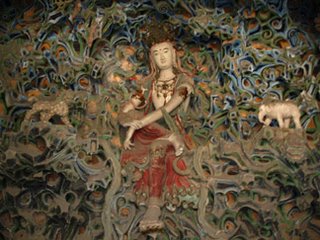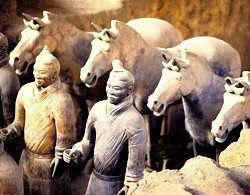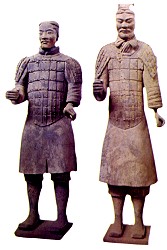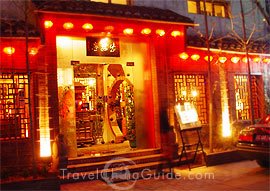Chinese marriage became custom during the Warring States period (402-221 B.C.). Due to the vast expanse and long history of Chinese marriage customs and ceremonies, there are different practices that are followed in different places, although they all generally adhere to similar guidelines. Visitors still have opportunities to witness traditional marriages in the countryside.
In ancient times, it was very important to follow a basic principle of the "Three Letters and Six Etiquettes" since they were essential to a marriage.
The "Three Letters" included the Betrothal Letter, Gift Letter and Wedding Letter. The Betrothal Letter was the formal document of the engagement, a must in a marriage. Next was the Gift Letter, which would be given to the identified girl's family. Within the letter would be a list of the types and quantity of gifts designated for the wedding, once both parties accepted the marriage. The Wedding Letter was prepared and presented to the bride's family on the day of the wedding and was a document that confirmed and commemorated the formal acceptance of the bride into the bridegroom's family.
Six Etiquettes
Proposing: If an unmarried boy's parents identified a girl as their future daughter-in-law, they would then locate a matchmaker. Proposals were the specialties of the matchmakers. The matchmaker would formally present his or her client's request to the identified girl's parents.
Birthday matching: If the potential bride's parents did not object to the marriage, the matchmaker would then ask for the girl's birthday and birth-hour to assure the compatibility of the potential bride and bridegroom. If the couple's birthdays and birth-hours did not conflict according to astrology, the marriage would continue onto the next stage. If there was any sign of astrological conflict, which meant the marriage would bring disasters upon both families, the proposed marriage was immediately quashed.
Presenting betrothal gifts: Once both birthdays matched, the bridegroom's family would then arrange for the matchmaker to present betrothal gifts, including the betrothal letter, to the bride's family.
Presenting wedding gifts: After the betrothal letter and betrothal gifts were accepted, the bridegroom's family would later formally send wedding gifts to the bride's family. Usually, gifts may include tea, lotus seeds, longan, red beans, green beans, red dates, nutmeg, oranges, pomegranate, lily, bridal cakes, coconuts, wine, red hair braid, money box and other delicacies, depending on local customs and family wealth.
Picking a wedding date: An astrologist or astrology book would be consulted to select an auspicious date to hold the wedding ceremony.
Wedding ceremony: On the selected day, the bridegroom departs with a troop of escorts and musicians, playing cheerful music all the way to the bride's home. After the bride is escorted to the bridegroom's home, the wedding ceremony begins.
Unlike Western tradition, the color red dominates traditional Chinese weddings. Chinese people tend to use or wear red to add a joyful atmosphere of such a festive occasion.
At dawn on the wedding day and after a bath in water permeated with grapefruit, the bride puts on new clothes, wears a pair of red shoes and waits for the so-called "good luck woman" to dress her hair in the style of a married woman. Her head would be covered with a red silk veil with tassels or bead strings that hang from the phoenix crown. She waits for her future husband to escort her home, with married women talking around her about how to be a good wife.
On the other hand, the bridegroom prepares himself to receive his wife. He gets capped and dressed in a long gown, red shoes and a red silk sash with a silk ball on his chest. The groom kneels at the ancestral altar as his father puts a cap decorated with cypress leaves on his head to declare his adulthood and his family responsibility.
Then the bridegroom sets out to receive his bride. Usually a crowd of friends escorts the bridegroom and musicians play joyful tunes during the entire trip. Dancing lions, if any, precede the troop. In ancient times, a bridal sedan chair (or a decorated donkey due to poverty or bad traffic) would be used to transport the bride. A child carries a bridal box among the people, reflecting the bridegroom's expectation to have a child in the near future.
The most interesting part of the reception really takes place at the doorstep of the bride's residence, which is heavily guarded by the bridesmaid or the bride's sisters. It is customary for the bridesmaid to give the bridegroom a difficult time before he is allowed to enter. Usually wisdom, courage and his friends will help the bridegroom to succeed in his "trial". However, there is one more situation he has to negotiate with the bridesmaid and sisters of the bride - to distribute among them red packets containing money - in order to take his bride home.
Before the bride departs to the bridegroom's home, the "good luck woman" will lead her to the sedan chair. On her way to the chair, one of her sisters will shield her with a red parasol, while another sister will throw rice at the sedan chair. At the back of the sedan hang a sieve and metallic mirror that are believed to protect the bride from evil. The bride has to cry to show that she does not want to leave her parents.
Then firecrackers will be set off to drive away evil spirits as the bride sits into the sedan chair. All along the way people make great efforts to avoid any inauspicious influence. For instance, the sedan chair is heavily curtained to prevent the bride from seeing an unlucky sight (e.g. a widow, a well or even a cat). When the parading troop arrives at the bridegroom's, firecrackers will be set off to hail the bride's arrival. Before the sedan chair a red mat is placed so that the bride will not touch the bare earth. By the threshold, a flaming stove and saddle will be set up and the bride is required to sidestep or step over them to avoid evils.
The wedding ceremony is the focus of interest. The bride and bridegroom are led to the family altar, where the couple kowtows to Heaven and Earth, the family ancestors and parents successively. They then bow to each other and are led to the bridal chamber. The ceremony proceeds under a director's prompts and applauses of the audience.
Afterwards, a grand feast is held for relatives and those who helped with the wedding. The newly wed couple will resume drinking wedding wine. Generally they are required to cross their arms to sip wine. They also will toast their guests. Guests voice their good wishes for the couple even though the bridegroom is trying to be humble while acting embarrassed.
Teasing games in the bridal chamber: After night falls, the teasing games start. Usually all young men can participate except for the bride's married brothers-in-laws. These funny and silly games help ease the tension, since in ancient times the newlyweds never met each other before the wedding! Most of the games require the shy couple to act like wife and husband. The festive atmosphere also promotes closeness among all the family members and the community beyond. There also will be other activities conducted by the bridegroom's mother after the roaring laughter fades into the darkness.
Preparing the bridal bed: A "good luck man", usually having a nice family, will help to install the bridal bed in the correct place in the bridal chamber on a selected day before the wedding day. Before the wedding, a "good luck woman" will arrange the bridal bed and scatter symbolic and lucky fruits on the bed. Nobody is allowed to touch the bed until the couple enters the bridal chamber after the wedding ceremony. Children will then be invited onto the bed to bless the couple with fertility.
Dowry: Usually the bride's dowry shall be sent to the bridegroom's family by the day before the wedding day. Sometimes the dowry will be brought by the bride's escorts. A traditional dowry normally consists of valuable items such as jewelry, embroidered beddings, kitchen utensils and furniture. The type of the dowry is constantly changing except for the basic, symbolic items. For example, dozens of years ago, a sewing machine, a bicycle, and a recorder were musts in a marriage. Now, they are totally out of fashion.
Bride's Return: Traditionally, the newlyweds are to return to visit the bride's parents one or three days after the wedding. They will be hailed with a banquet and it is the bridegroom's turn to suffer the well-intentioned teasing of the bride's relatives and friends.
Traditional marriage customs lost their popularity due to the collapse of feudal marriage customs and their complexity. However, traditional marriage can still be seen in the countryside, despite innovations. Now, traditional marriage customs are being revived in some places and they are attracting many prospective couples.




























